Thermal cameras have revolutionized nighttime wildlife conservation by allowing you to see what's invisible to the naked eye. They detect heat signatures of animals, enabling non-invasive observation of nocturnal species without disturbing their natural behaviors. You can monitor elusive creatures, track migrations, and assess population densities with unprecedented accuracy. These cameras also aid in anti-poaching efforts, helping protect endangered species from threats under cover of darkness. By integrating thermal technology with drones, you'll expand your reach and efficiency in wildlife research and protection. From identifying sick animals to uncovering hidden habitats, thermal imaging opens up a world of possibilities for conservation efforts after sunset.
Thermal Imaging Basics

Thermal imaging cameras pick up on heat signatures emitted by objects and living beings. They work by detecting infrared radiation, which is invisible to the naked eye but can be converted into visible images. You'll see these images displayed in various color palettes, with warmer objects typically appearing brighter or in warmer colors like red and orange.
Unlike traditional night vision devices that amplify available light, thermal cameras don't require any light source to function. This makes them incredibly useful for observing wildlife in complete darkness. You can spot animals hidden in dense vegetation or camouflaged against their surroundings.
The technology behind thermal imaging involves specialized sensors called microbolometers. These detect minute temperature differences and create a thermal map of the scene. Modern thermal cameras can detect temperature variations as small as 0.05°C, allowing for incredibly detailed imaging.
You'll find thermal cameras particularly effective for detecting warm-blooded animals against cooler backgrounds. They're also useful for identifying injured or sick animals, as their body temperatures may differ from healthy individuals.
However, it's essential to recognize that thermal imaging can't penetrate glass or water, which can limit their use in certain environments.
Nocturnal Wildlife Challenges
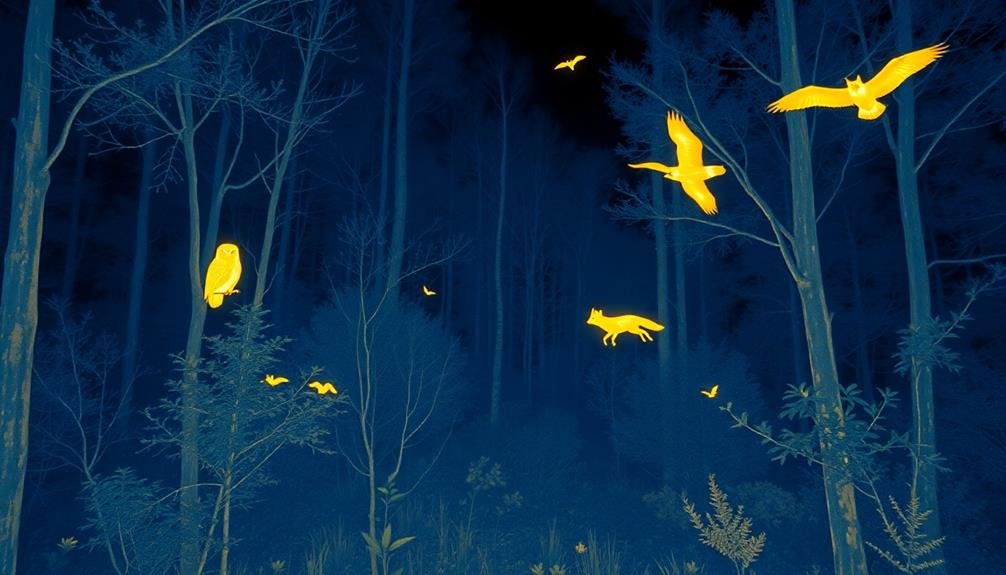
You'll face significant hurdles when studying nocturnal wildlife due to limited visibility at night.
Traditional methods often fall short in detecting elusive species that are active under cover of darkness.
Thermal cameras offer a solution, allowing you to spot warm-blooded animals against cooler backgrounds, even in complete darkness.
Limited Visibility Issues
During nighttime hours, wildlife conservationists face significant challenges in observing and protecting nocturnal animals. The darkness severely limits your ability to detect and monitor these creatures effectively. You'll struggle to identify species, track movements, or assess behaviors without adequate lighting.
Traditional flashlights or spotlights can disturb wildlife, altering their natural behaviors and potentially causing stress. These artificial light sources may also attract unwanted attention from predators or poachers. You'll find it difficult to maintain a safe distance while still gathering essential data.
Even with night vision equipment, you're often restricted by its limited range and inability to penetrate dense vegetation. Fog, mist, or light rain can further impair visibility, making it challenging to spot animals camouflaged in their surroundings. You'll miss subtle details and struggle to accurately count population numbers.
These visibility issues also pose safety risks for researchers working in the field. You can't easily spot potential hazards like uneven terrain, obstacles, or dangerous wildlife. Consequently, you're forced to move slowly and cautiously, reducing the efficiency of your conservation efforts and limiting the areas you can effectively cover during nighttime observations.
Elusive Species Detection
Nocturnal wildlife presents a unique set of challenges for conservationists. Many elusive species are active only at night, making them difficult to observe and study using traditional methods. Thermal cameras have revolutionized our ability to detect and monitor these creatures in their natural habitats.
You'll find that thermal imaging can reveal animals that would otherwise remain hidden. It detects heat signatures, allowing you to spot warm-blooded creatures against cooler backgrounds. This technology is particularly useful for locating:
| Species | Habitat | Behavior |
|---|---|---|
| Bats | Caves, forests | Echolocation, insect hunting |
| Owls | Woodlands, grasslands | Silent flight, rodent predation |
| Leopards | Forests, savannas | Stealthy hunting, tree climbing |
With thermal cameras, you're able to observe natural behaviors without disturbing the animals. This non-invasive approach provides valuable insights into nocturnal species' activities, population dynamics, and habitat use. You can track movement patterns, identify feeding areas, and even locate nesting sites that would be nearly impossible to find during daylight hours.
Drone Integration for Conservation

Drones equipped with thermal cameras have revolutionized wildlife conservation efforts, especially at night. You'll find these aerial tools invaluable for monitoring large areas efficiently and safely. They allow you to cover vast territories that would be challenging or dangerous to navigate on foot, particularly in darkness or rough terrain.
With thermal drone technology, you can detect and track animals without disturbing them or putting yourself at risk. You'll spot warm-bodied creatures against cooler backgrounds, making it easier to count populations, observe behavior, and identify potential threats. This integration enables real-time data collection and quick response to poaching activities or animals in distress.
You'll appreciate the versatility of drone-mounted thermal cameras for various conservation tasks. Use them to monitor endangered species, track migration patterns, or assess habitat health.
They're also excellent for anti-poaching operations, allowing you to patrol protected areas silently and effectively. By combining the aerial perspective of drones with the heat-sensing capabilities of thermal cameras, you're equipped with a powerful tool that enhances your ability to protect and study wildlife in their natural habitats.
Heat Signatures of Animals

You'll find that thermal cameras can reveal species-specific heat patterns, allowing for easier identification of animals at night.
These devices can detect subtle temperature variations, helping you distinguish between different species or even individuals within a population.
Species-Specific Thermal Patterns
Thermal fingerprints are unique to each animal species, offering conservationists a powerful tool for identification and monitoring.
You'll find that larger mammals like elephants and rhinos emit more heat, creating bright, distinct patterns on thermal cameras. In contrast, smaller creatures like rodents and birds show subtler heat signatures.
These species-specific patterns allow you to distinguish between different animals, even in complete darkness. For instance, you can identify a lion's elongated body shape and warm paw prints, while a giraffe's long neck and legs create a distinctive thermal silhouette.
Reptiles, being cold-blooded, appear cooler on thermal imaging but still show unique patterns based on their body structure.
You'll notice that aquatic animals like hippos and crocodiles display interesting thermal contrasts when partially submerged. The exposed parts of their bodies appear warmer against the cooler water.
Temperature Variation Detection
Detecting subtle temperature variations, thermal cameras excel at revealing the heat signatures of animals in their natural habitats.
You'll find that these devices can distinguish between warm-blooded creatures and their cooler surroundings, even in complete darkness. As animals move through their environment, they leave behind thermal traces that you can observe and analyze.
You'll notice that different species exhibit unique heat patterns. Large mammals like deer or bears produce more pronounced thermal signatures, while smaller creatures like rodents or birds have subtler heat profiles.
Thermal cameras can detect these variations, allowing you to identify and track animals without disturbing them.
You can use this technology to monitor nocturnal behaviors, locate hidden dens or nests, and assess population densities. By detecting temperature anomalies, you might even spot injured or sick animals that require intervention.
The ability to observe wildlife in their natural state, without the need for artificial lighting, gives you unprecedented insights into ecosystem dynamics.
With thermal imaging, you're able to conduct non-invasive research, improve conservation efforts, and gain a deeper understanding of wildlife behaviors and patterns in their nighttime habitats.
Camouflage-Breaking Infrared Imaging
Beyond detecting temperature variations, thermal cameras offer a game-changing advantage in wildlife observation: the ability to break through natural camouflage.
You'll find that animals' heat signatures stand out clearly against cooler backgrounds, regardless of their coloration or patterns. This infrared imaging technique reveals creatures that would otherwise blend seamlessly into their environment.
With thermal cameras, you can spot well-camouflaged predators like leopards or jaguars as they stalk through dense foliage.
You'll also detect prey animals like deer or rabbits hiding motionless in tall grass. Even reptiles and amphibians, which are often difficult to see due to their coloration, become visible as warm spots against cooler surroundings.
In aquatic environments, thermal imaging helps you locate marine mammals and fish just below the water's surface.
You'll see warm-blooded animals as they come up to breathe, even in low-light conditions. This technology proves invaluable for monitoring nocturnal species, tracking elusive animals, and conducting accurate population surveys.
Poaching Prevention at Night

At night, when darkness shrouds wildlife habitats, poachers often strike.
But thermal cameras are changing the game, giving conservation teams a powerful tool to combat illegal hunting. You'll find these devices transforming nighttime anti-poaching efforts by detecting heat signatures of both humans and animals in complete darkness.
With thermal imaging, you can:
- Spot poachers from a distance, even when they're hiding
- Identify animals at risk and monitor their movements
- Distinguish between different species based on their heat profiles
- Coordinate rapid response teams more effectively
You're able to see through smoke, fog, and light vegetation, making it nearly impossible for poachers to conceal themselves.
These cameras don't require visible light, so they won't disturb wildlife or alert intruders to your presence.
They're also effective in detecting recently killed animals, as their bodies retain heat for hours.
Population Counting in Darkness
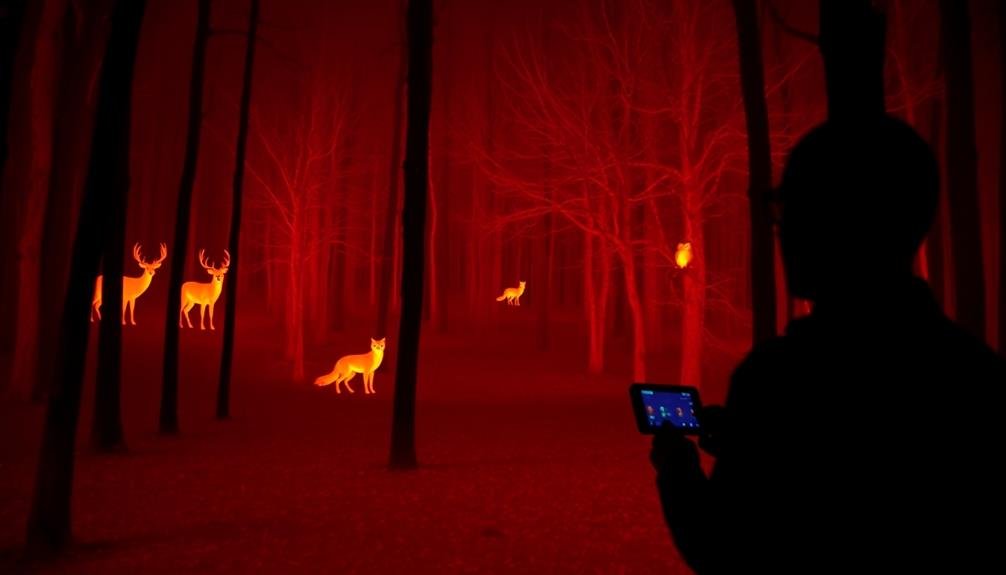
Thermal cameras aren't just for catching poachers; they're revolutionizing wildlife population counts after dark. You can now accurately estimate animal numbers in their natural habitats without disturbing them. These cameras detect heat signatures, allowing you to spot warm-blooded creatures even in complete darkness or dense vegetation.
You'll find thermal imaging particularly useful for nocturnal species that are typically hard to count using traditional methods. It's easier to differentiate between individuals and avoid double-counting. You can conduct surveys over large areas more efficiently, covering more ground in less time compared to spotlight counts or camera traps.
With thermal cameras, you'll also minimize human bias in population estimates. The technology provides clear, objective data that you can analyze later. You'll reduce the risk of missing animals or misidentifying species, leading to more accurate conservation assessments.
Habitat Monitoring After Sunset

You'll find thermal cameras invaluable for monitoring wildlife habitats after dark.
These devices allow you to track nocturnal species' activities, revealing important patterns in their behavior and movement.
Additionally, you can assess vegetation health at night, detecting temperature variations that might indicate stress or disease in plants vital to the ecosystem.
Nocturnal Species Activity Tracking
During the dark hours, thermal cameras reveal a hidden world of nocturnal wildlife activity. You'll witness animals that are rarely seen during daylight hours, gaining valuable insights into their behavior and ecology.
These cameras detect heat signatures, allowing you to observe wildlife without disturbing them or using artificial light that might alter their natural patterns.
With thermal imaging, you can track:
- Hunting behaviors of predators like owls and big cats
- Foraging patterns of nocturnal herbivores
- Mating rituals and courtship displays
- Movement and migration routes of various species
You'll be able to identify individual animals based on their unique heat signatures, making it easier to monitor population dynamics and track specific individuals over time.
This technology also helps you detect invasive species that may be active at night, allowing for more effective management strategies.
Vegetation Health Assessment
At night, the health of vegetation becomes visible through thermal imaging, offering a unique perspective on habitat quality. You'll find that thermal cameras can detect subtle temperature variations in plants, revealing essential information about their physiological state.
Healthy vegetation typically appears cooler than stressed or diseased plants, allowing you to identify problem areas quickly.
With thermal imaging, you can assess drought stress, pest infestations, and nutrient deficiencies across large swaths of habitat. This technology enables you to monitor the overall ecosystem health and make informed conservation decisions.
You'll be able to track changes in vegetation patterns over time, identifying areas that require intervention or protection.
Thermal cameras also help you detect illegal logging or clearing activities that might occur under the cover of darkness. By comparing thermal signatures of undisturbed areas with those showing signs of human interference, you can quickly pinpoint potential threats to the habitat.
Moreover, you can use thermal imaging to identify water sources and assess their impact on surrounding vegetation. This information is crucial for understanding wildlife movement patterns and habitat preferences, especially in arid environments where water availability is essential for ecosystem health.
Species Identification Without Light
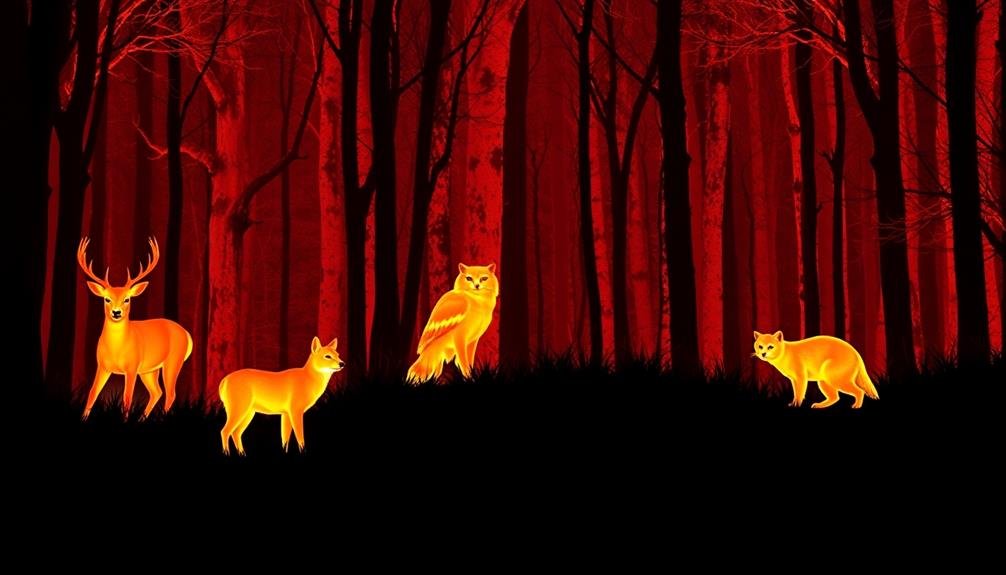
While traditional wildlife observation methods often rely on visual cues, thermal cameras offer a unique advantage for species identification in complete darkness. You'll find that these devices detect heat signatures emitted by animals, allowing you to distinguish between different species based on their unique thermal profiles. This technology enables you to identify and track nocturnal animals that are typically elusive during daylight hours.
With thermal cameras, you can:
- Differentiate between warm-blooded and cold-blooded animals
- Detect animals hidden in dense vegetation or camouflaged environments
- Observe natural behaviors without disrupting them with artificial light
- Estimate population sizes more accurately in low-visibility conditions
You'll appreciate how thermal imaging helps you recognize specific body shapes, sizes, and movement patterns characteristic of different species. This non-invasive approach minimizes stress on wildlife and reduces the risk of altering their natural behaviors.
Minimizing Wildlife Disturbance

Thermal cameras offer a significant advantage in minimizing wildlife disturbance during nighttime conservation efforts. Unlike traditional flashlights or spotlights, thermal imaging devices don't emit visible light, allowing you to observe animals in their natural state without alerting them to your presence.
This non-invasive approach is essential for accurate behavioral studies and population counts. You'll find that thermal cameras enable you to maintain a greater distance from wildlife, reducing stress and potential flight responses. This is especially important for sensitive species or those in critical habitats.
By avoiding direct contact, you're less likely to disrupt feeding, mating, or resting behaviors. Additionally, thermal imaging helps you navigate through habitats more safely, minimizing accidental disturbances.
You can easily spot animals hidden in vegetation or camouflaged against their surroundings, allowing you to plan your movements accordingly. This technology also reduces the need for physical trapping or handling of animals for identification purposes.
Data Collection and Analysis
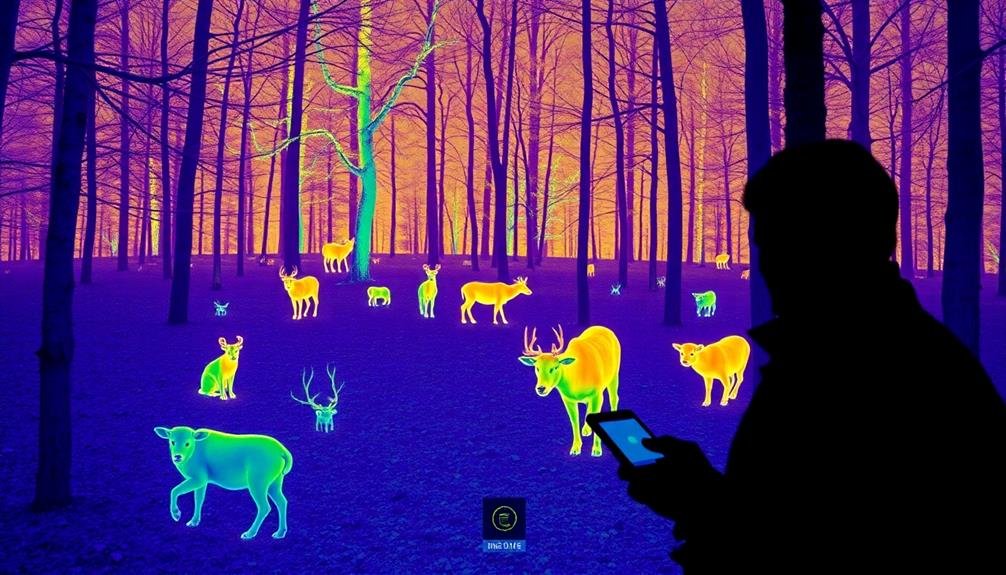
Conservation researchers' data collection and analysis capabilities are greatly enhanced by thermal imaging technology. You'll find that these cameras capture detailed heat signatures of animals, allowing you to identify species, count individuals, and observe behaviors without disrupting their natural patterns. This non-invasive approach provides a wealth of data that wasn't accessible before.
When you're analyzing the thermal footage, you'll be able to:
- Track animal movements and migration patterns
- Study nocturnal behaviors and interactions
- Assess population densities in specific areas
- Monitor the health of individual animals based on their heat signatures
You'll appreciate how thermal imaging simplifies data collection in challenging environments like dense forests or pitch-black nights. The technology's ability to detect animals through foliage and darkness means you'll gather more extensive data sets.
You can also automate much of the analysis process using artificial intelligence and machine learning algorithms. These tools will help you quickly process large volumes of thermal data, identifying trends and patterns that might otherwise go unnoticed.
Conservation Success Stories
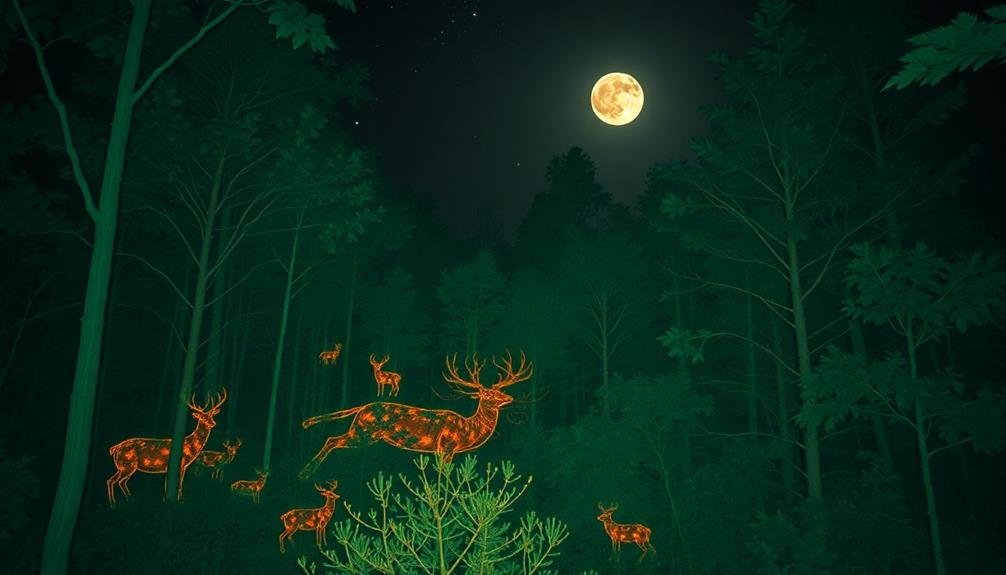
Success stories abound in the field of wildlife conservation thanks to thermal imaging technology. You'll find numerous examples of how these cameras have helped protect endangered species and combat poaching.
In South Africa, thermal cameras have markedly reduced rhino poaching incidents by allowing rangers to detect poachers before they can harm the animals. You've likely heard about the plight of sea turtles, but thermal imaging has improved their survival rates by identifying nesting sites and guiding hatchlings safely to the ocean.
In Australia, you'll see how thermal cameras have aided in locating and rescuing koalas during bushfires, saving countless lives. These devices have also revolutionized the study of nocturnal species like bats and owls, providing invaluable data on their behavior and habitat needs.
You can observe how researchers in the Amazon use thermal imaging to track elusive jaguars, contributing to more effective conservation strategies. In marine environments, you'll find thermal cameras helping to monitor whale populations and detect illegal fishing activities.
These success stories demonstrate the transformative impact of thermal imaging on wildlife conservation efforts worldwide.
Thermal Technology Limitations
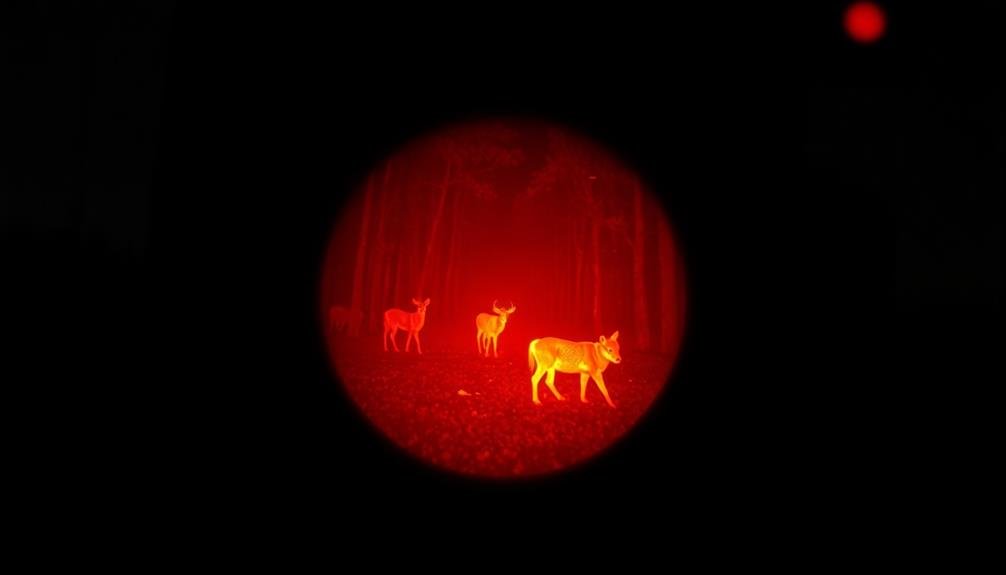
Despite their many advantages, you'll find that thermal cameras aren't without their limitations in wildlife conservation. These devices can't penetrate dense foliage or see through glass, which can restrict their effectiveness in certain habitats.
You'll also notice that thermal imaging doesn't provide color information, making it challenging to identify specific species or individuals based on visual markings.
Another limitation you'll encounter is the camera's inability to detect animals that are the same temperature as their surroundings. This can be problematic in environments where ambient temperatures closely match animal body temperatures.
Additionally, thermal cameras typically have a shorter range compared to traditional night vision devices, which may limit their usefulness in expansive habitats.
Here are some key limitations to keep in mind:
- Weather conditions like rain, fog, or humidity can interfere with thermal imaging
- High-quality thermal cameras can be expensive, limiting widespread adoption
- Interpreting thermal images requires specialized training and experience
- Thermal cameras may disturb nocturnal animals sensitive to infrared radiation
Despite these limitations, thermal cameras remain a valuable tool in nighttime wildlife conservation efforts when used appropriately and in conjunction with other technologies.
Future of Nighttime Wildlife Research

In light of advancing technology, the future of nighttime wildlife research looks promising. You'll see thermal imaging cameras becoming more affordable and accessible to researchers and conservationists. This will lead to increased data collection on nocturnal species' behaviors, population dynamics, and habitat use.
You can expect improvements in image resolution and detection range, allowing for more detailed observations from greater distances. Machine learning algorithms will enhance automatic species identification and behavior analysis, streamlining the research process.
You'll witness the integration of thermal cameras with other technologies, such as drones and satellite imaging, providing extensive ecosystem monitoring.
As thermal imaging becomes more widespread, you'll see a surge in citizen science initiatives, involving the public in nighttime wildlife observation and data collection. This will contribute to larger datasets and increased awareness of nocturnal biodiversity.
You can anticipate breakthroughs in understanding how climate change affects nighttime wildlife activities and adaptations. This knowledge will be essential for developing effective conservation strategies.
Ultimately, the future of nighttime wildlife research will bring unprecedented insights into ecosystem dynamics, helping you make informed decisions for wildlife protection and management.
Frequently Asked Questions
How Much Do Thermal Cameras for Wildlife Conservation Typically Cost?
You'll find thermal cameras for wildlife conservation ranging from $500 to $10,000+. Basic models start around $1,000, while high-end cameras with advanced features can cost $5,000 or more. Prices vary based on resolution and capabilities.
Can Thermal Cameras Detect Animals Underwater or in Dense Vegetation?
You'll find thermal cameras can't detect animals underwater, as water blocks infrared radiation. However, they're effective in dense vegetation, allowing you to spot animals through foliage based on their body heat. They're not foolproof, but quite useful.
Are There Legal Restrictions on Using Thermal Cameras for Wildlife Research?
Yes, there are legal restrictions on using thermal cameras for wildlife research. You'll need permits for certain species and protected areas. Check local regulations, as rules vary by location and research purpose. Always prioritize animal welfare.
How Long Does It Take to Train Personnel in Thermal Imaging Techniques?
Training time for thermal imaging techniques varies. You'll typically need 1-2 weeks for basic proficiency. However, you'll continue to improve with hands-on experience. Advanced skills may take months to develop, depending on your background and equipment complexity.
Can Thermal Cameras Distinguish Between Different Animal Species of Similar Size?
Yes, thermal cameras can distinguish between animal species of similar size. You'll notice differences in heat signatures, body shapes, and movement patterns. However, you'll need training and experience to accurately identify species solely through thermal imaging.
In Summary
You've seen how thermal cameras are transforming nighttime wildlife conservation. They're giving researchers unprecedented insight into nocturnal animal behavior and helping combat poaching. As technology improves, you'll witness even more applications in wildlife protection. While there are limitations, the future's bright for thermal imaging in conservation. You can expect this tool to play an essential role in preserving biodiversity and protecting endangered species for years to come.

As educators and advocates for responsible drone use, we’re committed to sharing our knowledge and expertise with aspiring aerial photographers.
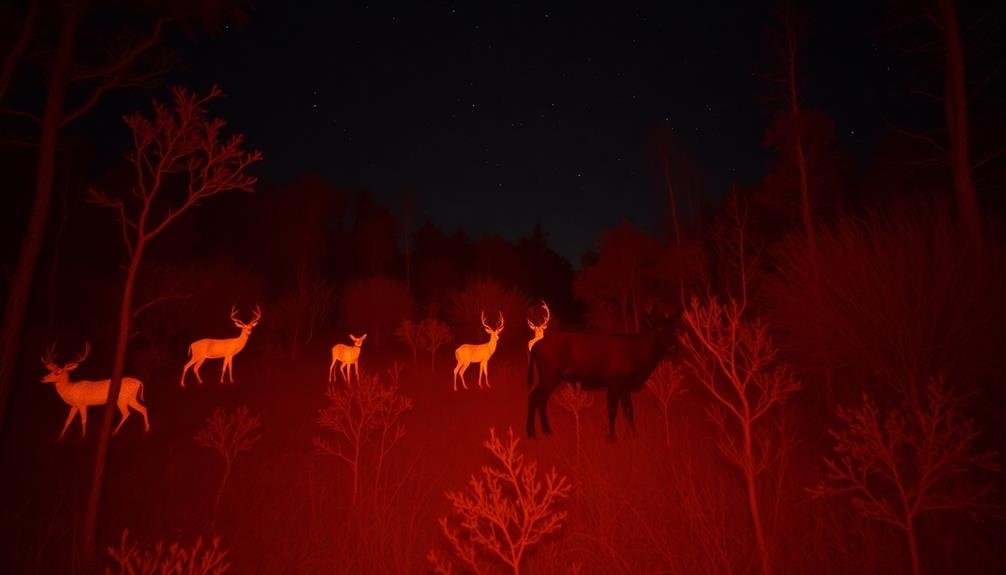



Leave a Reply